The Cyclades Islands
Ideal Charterter Duration
Let your dream come true: Cyclades Islands
- 20-30 days, would be the ideal charter duration for those wishing to visit most of the Cyclades islands, as each one has so many amazing experiences to offer.
- 14-20 days would be enough to visit the most interesting islands and acquire a satisfactory taste of the area.
- In 7 days, yachters will face the difficulty to choose only 4-8, among the 24 amazing islands, depending on their yachts speed, weather conditions and the time they want to spend sailing.
- Please do not hesitate to ask us for the perfect root depending the time you will spend on the Islands.
To speak with a charter professional at HELLAS YACHTING 24/7 Telephone: +30 6948 295 207 or mail us: info@hellas-yachting.com
The most famous island group of 56 islands in the Aegean Sea comprises some of the most beautiful islands in the world! Gorgeous sandy beaches, architecture in white and blue, traditional lifestyle, folk music, warm, hospitable people and barren landscapes with isolated chapels turn a trip to the Cyclades into a lifetime experience.


Delos
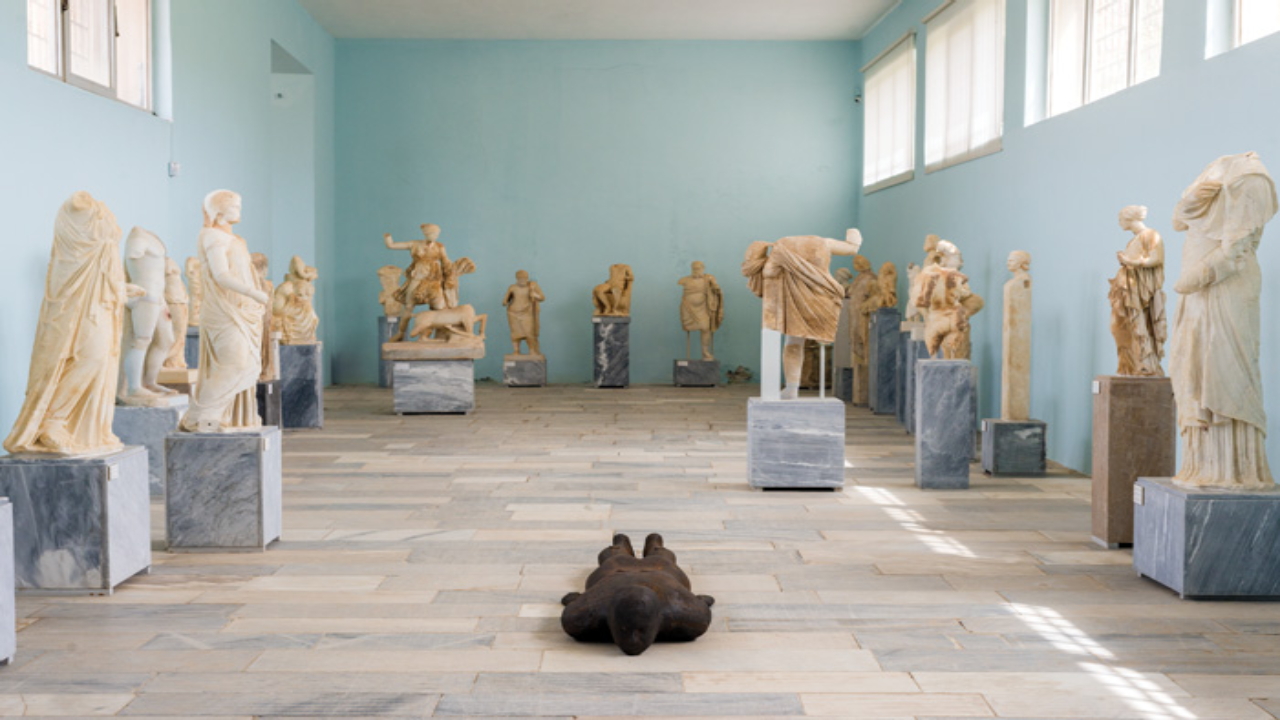
Delos, the birth place of Apollo and Artemis, used to be a religious centre for the whole of Greece in the ancient times, as well as the principal trading port in the Eastern Mediterranean during the roman times. Delos is uninhabited today and is listed as a UNESCO world heritage site, receiving large numbers of visitors who flock to admire remarkable monuments and impressive mosaics.
Mykonos
One of the most famous destinations worldwide and a favourite holiday spot of the jet set, Mykonos, is extremely beautiful and well known for its bare hills, the amazing sandy beaches, the white country chapels and the Cycladic architecture.
The most famous cosmopolitan island, a whitewashed paradise in the heart of the Cyclades. According to mythology, Mykonos was formed from the petrified bodies of giants killed by Hercules. And the island took its name from the grandson of Apollo named “Mykonos”
In contrast to other Cycladic capitals, the capital town (Hóra) of the island is not built in the shape of an amphitheatre but instead spreads out over a wide area. It is one of the best examples of Cycladic architecture and a spellbinding attraction for visitors. Stroll around its narrow marble streets and admire whitewashed houses with colorful doors and window frames, bougainvillea trees in purple bloom and hidden churches. You can visit to the Archaeological, Folklore and Maritime Museums. Wander around the pedestrian shopping streets of the Hóra, always colorful and busy. The most glamorous of all is Matoyánni Street, lined with brand name stores, charming cafés and stylish restaurants.
Soak up the atmosphere along the lively waterfront and admire a fleet of fishing boats casting colorful reflections in the azure waters. This is where you will find the Kazárma building, which served as accommodation for the soldiers of Manto Mavrogenous, a heroine of the Greek Revolution.
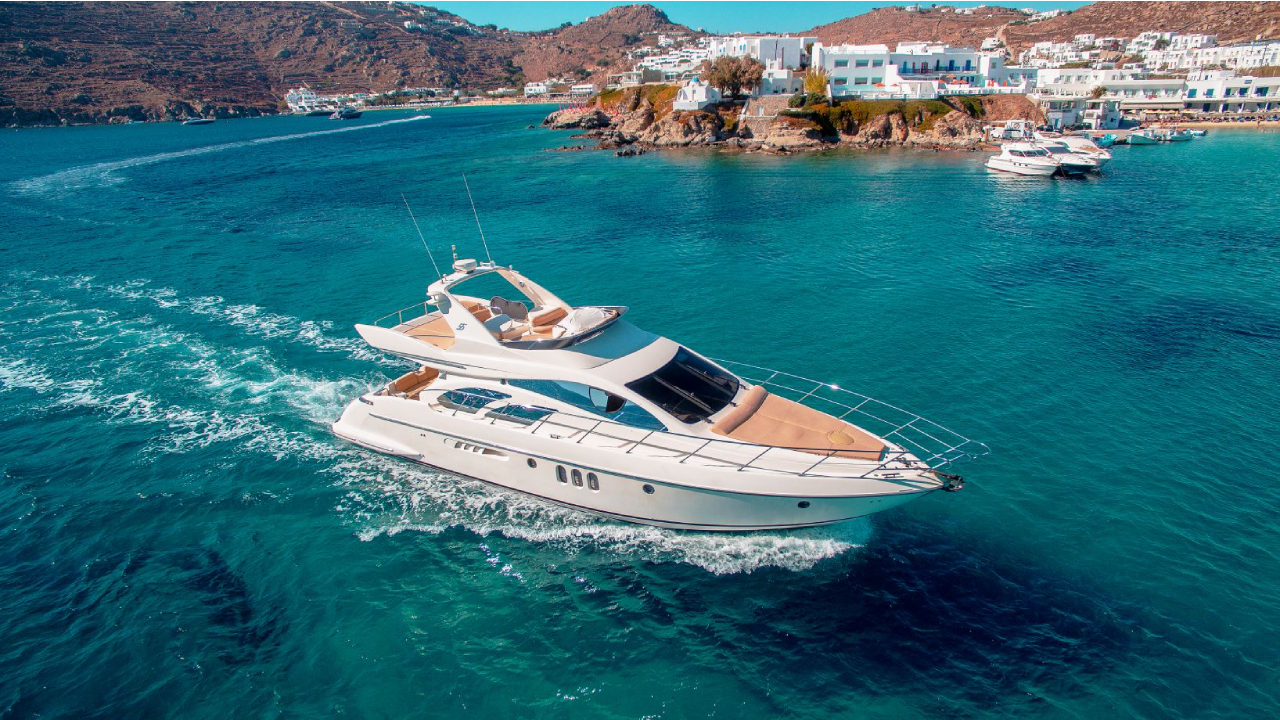
The first floor served as her personal residence.
While you’re out strolling, don’t be surprised if you come across the official mascot of Mykonos, which is nothing other than a… pelican! Pétros the Pelican was found by a fisherman after a storm in 1954, and eventually became the locals’ companion. When he died, the grief for his loss was so deep that a replacement was soon found.
One of the most scenic corners of the island is Alefkántra or “Little Venice”, an 18th century district, dominated by grand captains’ mansions with colorful balconies and stylish windows.
The second traditional settlement of Mykonos is Áno Merá, situated around the historic monastery of Panayia Tourliani (a 16th century church with a brilliant carved wooden iconostasis). To the north, in Fteliá, lies an important Neolithic settlement, and a 14th-13th century BC Mycenaean tomb.
Using the Hóra as your base, set out on a trip to discover the beauties of the island, in particularly its sun-kissed beaches.
The island is a paradise for water sport enthusiasts! It is only natural that the “Island of the Winds” should attract surfers and sailors from all over the world!
If you find yourself in Mykonos take the opportunity to explore the tiny archaeological gem of Delos Island, just a short boat trip away. Delos was a sacred island in ancient times, and according to mythology was the birthplace of the twin gods Apollo and Artemis. It’s a an ark of history, floating lazily on the waters of the Aegean Sea, just a few miles away from cosmopolitan Mykonos. It’s a chance to walk around the revival of the glory of the Greek civilization. It’s the head priest of the Cyclades, the birthplace of the immortals. It’s Delos.
Nowadays, Delos reserves its uniqueness to the know world: nowhere else in the Globe is there a natural insular archaeological site of this size and importance. No other island on Earth hosts so many monumental antiquities from the Archaic, the Classical, and the Hellenistic periods, i.e. the centuries of the great Greek art, on a territory used exclusively as an archaeological site. Delos is not a museum; Delos is not there to tell a story. Delos is history itself.
Santorini
Cousteau looked for the lost city of Atlantis on Santorini. Crescent-shaped Santorini (or Thíra), the precious gem of the Aegean, is actually a group of islands consisting of Thíra, Thirassiá, Asproníssi, Palea and Nea Kaméni in the southernmost part of Cyclades.

Jean Jack Cousteau looked for the lost city of Atlantis here. On Santorini
Crescent-shaped Santorini (or Thíra), the precious gem of the Aegean, is actually a group of islands consisting of Thíra, Thirassiá, Asproníssi, Palea and Nea Kaméni in the southernmost part of Cyclades.
The whole complex of Santorini islands is still an active volcano and probably the only volcano in the world whose crater is in the sea. The islands that form Santorini came into existence as a result of intensive volcanic activity; twelve huge eruptions occurred, one every 20,000 years approximately, and each violent eruption caused the collapse of the volcano’s central part creating a large crater (caldera). The volcano, however, managed to recreate itself over and over again.
The last big eruption occurred 3,600 years ago (during the Minoan Age), when igneous material (mainly ash, pumice and lava stones) covered the three islands (Thíra, Thirassiá and Asproníssi). The eruption destroyed the thriving local prehistoric civilization, evidence of which was found during the excavations of a settlement at Akrotíri. The solid material and gases emerging from the volcano’s interior created a huge “vacuum” underneath, causing the collapse of the central part and the creation of an enormous “pot” –today’s Caldera– with a
size of 8×4 km and a depth of up to 400m below sea level.
The eruption of the submarine volcano Kolúmbo, located 6.5 km. NE of Santorini, on 27th September 1650, was actually the largest recorded in Eastern Mediterranean during the past millennium! The most recent volcanic activity on the island occurred in 1950. The whole island is actually a huge natural geological/volcanological museum where you can observe a wide range of geological structures and forms!
Santorini is considered to be the most sought after place for a romantic getaway in Greece, since there are not many places in the world where you can enjoy exquisitely clear waters while perched on the rim of a massive active volcano in the middle of the sea! The island has a growing reputation as a “wedding destination” for couples not only from Greece but from all over the world. A trip to Santorini with the other half is a dream for anyone who has seen at least one photo of the island’s famous Caldera and exchanging kisses beneath Santorini’s famous sunset is the ultimate romantic experience!
Firá is the picturesque capital of the island; perched high up on the edge of the Caldera, it looks like a marvelous painting. Firá, together with Oia, Imerovígli and Firostefáni located high above on a cliff, make up the so-called “Caldera’s eyebrow”, the balcony of Santorini, which offers an amazing view of the volcano. Other famous smaller villages are Akrotíri and Méssa Vounó, with their famous archaeological sites, Pýrgos, Karterádes, Emporió, Ammoúdi, Finikiá, Períssa, Perívolos, Megalohóri, Kamári, Messariá and Monólithos: some of the villages are cosmopolitan some more peaceful; they are surrounded by vast vineyards; whitewashed cliff-top towns with castles affording amazing views out over the Aegean. Soaking up the villages’ distinctive traditional atmosphere is a very rewarding experience.
Venture into Santorini’s seaside treasures and enjoy deep blue waters and beaches with white, red or black sand or volcanic pebbles, spectacular rock formations and impressive lunar landscapes.
Santorini, the youngest volcanic land in the Eastern Mediterranean, is waiting for you! You can reach it by plane or by ship from Piraeus. Don’t think twice! Experience for yourself the once-in-a-lifetime romance and charm of this pearl of the Aegean.
Hellas Yachting can travel you by boats to the nearby islands of Santorini and around the island itself under the rocks that have been nests for her villages and take you around the volcano that still smokes and reminds its birth. Also can proposes you the accommodation on her towering cliffs, who looks like nests. If you stay there you can dream of touching the stars of the spotless night sky and you can make wishes for eternal desires when you are watching the falling stars.
Andros
Andros is the northernmost island of the group with a great naval tradition and no landscape like the postcards from the Cyclades: apart from the sandy beaches, there are rocky coastlines, mountain ranges alternating with fertile plains, lush vegetation and abundantly flowing streams.
It is the northernmost island of the group with a great naval tradition and no landscape like the postcards from the Cyclades: apart from the sandy beaches, there are rocky coastlines, mountain ranges alternating with fertile plains, lush vegetation and abundantly flowing streams.
The capital of the island, Hóra (which means “main village”) is home to famous Greek captains and ship owners, and there is a remarkable combination of medieval, neoclassical and island style evident in its houses. Flights of stairs, a spacious square with trees, narrow streets, remarkable churches and museums, shops, cafes and restaurants play their part in the beauty of the place. To top that beauty off, there is a Frankish castle on an islet connected to the main island with an arched stone bridge of the 13th century.
Enjoy the flora of the main island: chestnut, walnut, sycamore, oak, weeping willows, poplar, mulberry, osier and olive trees, fields of thyme, crocus and sage, and, in between, paved paths connect them to the beautiful village of Messariá and the village of Faneroméni within a castle that is ten centuries old and perched at an elevation of 600 m. Don’t forget to pay a visit at the monasteries of Zoodóchos Piyí in Batsí and of Panayia Tomarhiani in Korthi.
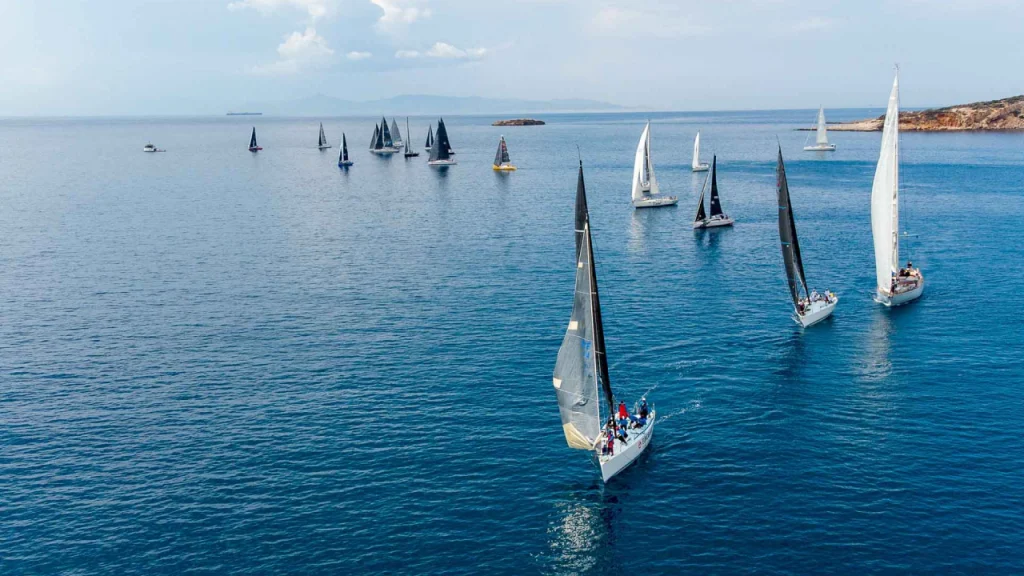
Paleópolis lies at 16 km west of Hóra, and used to be the ancient capital town of Ándros, having prospered from the classical to the late roman times. The prehistoric settlement of Pláka, the settlement of Zagora dating to the Geometric period, and the fortified settlement of the Neolithic times (4,500-3,300 BC) with rock paintings of animals, ships and linear designs have all been unearthed in the wider area.
Ándros is definitely worth a visit and can be seen solely as a cultural tourism destination, thanks to its museums. The globally acknowledged Museum of Modern Art, managed by the Vassilis and Eliza Goulandris Foundation, houses unique collections of paintings and sculptures, whereas the archaeological museums in Hóra and Paleópolis represent the ancient history of the island with their exhibits. The Cyclades Olive Museum is a fine example of a small pre-industrial, animal powered, olive oil producing unit that is definitely a must-see site.
Hellas Yachting can take you by boat to the nearby islands of Andros and around the Cyclades islands. You can travel by Hellas Yachting to the Aegean Sea and feel its aura, you can hear the waves’ whispers telling you tales about the pirates and make your vacancies unforgettable. Also Hellas Yachting can recommend you accommodation in amazing hotels by the sea that will spoil you. You deserve it!
Paros
Paros is the paradise of Kit-Surfing.
Unrivalled natural beauty, beaches of crystal clear waters, “unique” Byzantine footpaths connecting traditional villages and breathtaking landscapes make Paros, located at the heart of Cyclades, one of the most beloved holiday destinations in Greece…
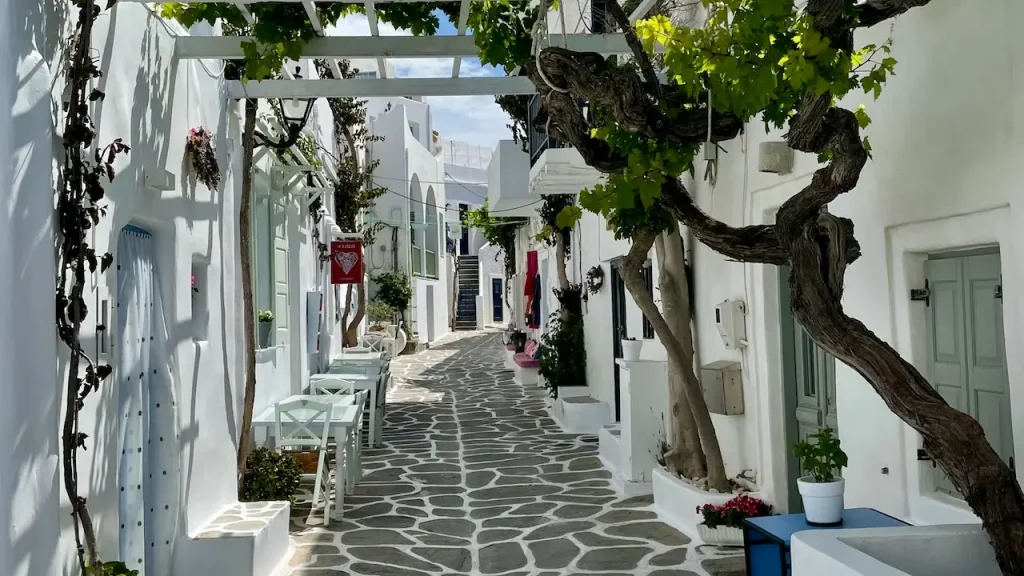
Paros History
Unrivalled natural beauty, beaches with crystal clear waters, unrivalled Byzantine footpaths connecting traditional villages and breathtaking landscapes make Páros, located at the heart of the Cyclades, one of the best loved holiday destinations in Greece.
Parikía (Parikiá), the capital of Páros, is a beautiful Cycladic village with whitewashed cubic houses and impressive neoclassical mansions. A well preserved 13th century Venetian castle stands proudly on a hill at the centre of the village offering an amazing view of Parikía. In the capital you can also admire an important ecclesiastical monument, the 6th century church of Panayia Ekatontapyliani, also called Katapoliani. The name “Ekatontapylianí” means the church with 100 gates (“Ekató Pýles” in Greek), one of which is a secret one! Don’t miss the chance to visit the baptistery (4th century AD), one of the best preserved baptisteries in the Orthodox East, and the Byzantine Museum. The Parikía Byzantine Museum is housed on the ground floor of the church. Its exhibits include icons, wood-carved iconostases and other heirlooms from various monasteries and churches on the island.
The Archaeological Museum displays exhibits from the island’s monuments (such as the Sanctuary of Asklipios and Pythios Apollonas, Delion etc.), including part of the “Parian Chronicle”, a chronological table of the 3rd century BC with references to important events and personalities of antiquity.
Wander through beautiful traditional villages like Náoussa, a colorful village, where the ruins of a Venetian fortress stand at the entrance to its small harbor. Léfkes is located at the highest point of Páros and enjoys stunning views of the island. The Museum of Aegean Folk Culture at Léfkes offers a tour of the culture of the Archipelago; discover the Aegean world through its exhibits, which include pieces related to the architecture, traditional trades and geology of the islands.
The sun-drenched beaches, like Chrissí Aktí, Santa Maria and Poúnda, welcome sun-loving visitors who want to enjoy the crystal clear sea, the sun or even their favourite water sports. Every year Chrissí Aktí is the venue for the Windsurfing World Championship. On the sea bed at Alykí beach, to the southwest, you can explore the ruins of an ancient town!
You can live experience an exhilarating touring all around the coast of the island by canoe or kayak! Enjoy the unusual natural landscape with impressive white rock formations on Kolymbíthres beach. The beach of Kalóyeros, surrounded by red and green clay rocks offers a really effective spa for free! Cover your body with clay and let it dry in the sun; after a while rinse yourself in the sea and your body will feel softer than ever!
Extra tip: Don’t miss the opportunity to visit the small islet of Antíparos, lying southwest of Paros, which can easily be reached from Poúnda or Parikiá by boat. The Hora (Main Town) of Antíparos is built around a 15th century Venetian castle. The stone paved streets, the whitewashed alleys, the houses decorated with thriving pink and purple bougainvilleas and the central square in the shade of eucalyptus trees create an enchanting atmosphere.
Hellas Yachting’s boats can travel from Paros to Antiparos and any other island or beautiful beach you want. You can travel to the Aegean Sea and feel its aura, you can hear the waves’ whispers telling you tales about the pirates. Hellas Yachting also recommend you the accommodation that we have chosen especially for you.
Naxos
Naxos is the biggest and the greenest island in Cyclades with impressively high mountains, fertile valleys, lush green gorges, stunning seascapes and traditional villages perched high on mountain tops, where the inhabitants still wear their traditional dress and live off the fruits of the land! Nàxos is also an island of beautiful old churches, monasteries and Venetian castles coexisting harmoniously with Cycladic cubic houses.
NAXOS HISTORY
Unrivalled natural beauty, beNAXOS HISTORY
“Big Sweet has this island, virtuous are the faces of people, piles are shaped by melons, peaches, figs and the sea is calm. I looked at the people – never this people have been frightened by earthquakes or by Turks, and their eyes did not burn out.Here freedom had extinguished the need for freedom, and life spread out as happy sleeping water. And if sometimes was discomposed, never rose tempest. Safety was the first gift of island that I felt as walking around Nàxos.” (N. Kazantzakis, “Report to El.Greko”).
Upon entering the port, the whitewashed Hóra of Náxos and the islet of Palatia at its entrance form a most welcoming setting! On Palatia islet lies the impressive “Portára”, a marble gate of a 6th century BC temple of Apollo. According to mythology, the god Dionysus met Ariadni there, who had been abandoned by Thesseus. Hóra, the capital of Náxos, whose landmark is an imposing Venetian castle, is an old castle town with stone paved alleys (kalderímia) where you can admire a unique blend of Cycladic and Medieval architecture: mansions with Venetian blazons still decorating their entrances, narrow alleys with “stegadia” (arches), catholic churches and fortifications.
Visit the Archaeological Museum, housed in a historic building of the Venetian Period, housing finds from the Early Neolithic Age up to the Early Christian (Paleochristian) Period and an interesting collection of Cycladic figurines.
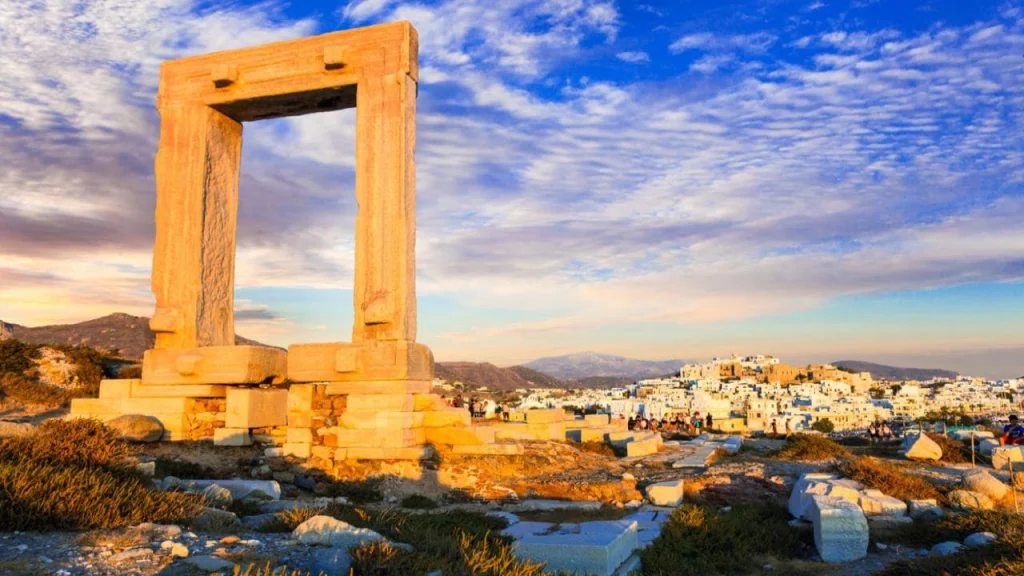
Discover the varied geomorphology and biodiversity of the island by following breathtaking routes all around the island (Hora–Melane-Halki, Halki–Danakos-Apeiranthos, Skado-Apollonas, etc.); follow the hiking trail from Apeíranthos (or Apérathos) to Moutsouna beach along the emery mines (12 km) and the breathtaking view to the Archipelagos (all the way!) will make it up to you! Climb to the top of Zas Mountain, Cyclades’ highest mountain (1,004 m) and Fanári Mountain (908 m) or follow beautiful biking routes around the mountains! On your way to Zas’ top, don’t forget to visit the beautiful cave of Zas, that used to be dedicated to Milosios Zeus and observe its impressive stalactite formations.
Explore traditional villages spread around the island, with a particular, “magical” character: Apérathos is a colorful mountainous village boasting five museums, stone-built houses, beautiful squares and narrow alleys paved with marble, and Panayia Drosiani, a beautiful church of the Early Christian Period! Filoti, built on the top of a rock, is a picturesque mountainous village surrounded by lush vegetation with cubic shaped houses and narrow stone-paved alleys. The 9th-10th century church of Panayia Protothroni, situated at a close distance, is the biggest Byzantine church of Nàxos with murals of great value. The community of Sagri consists of five small villages (Ano Sagri, Kato Sagri, Kanakari, Kastraki and Mikri Vigla). You will feel admiration before the Venetian towers, the traditional windmills and a number of major Byzantine churches, like Ayios Mamas, all of which make Sagri the Mystras of Náxos albeit on a smaller scale! Close to Sagri lies the 6th century BC Demeter and Apollo sanctuary, made exclusively of white marble.
Hellas Yachting can take you by boat to the nearby islands of Naxos and around the Cyclades islands and make your vacancies unforgettable. Also we can recommend you accommodation in amazing hotels by the sea that will spoil you. You deserve it!
Milos
The volcanic activity in ancient years has endowed this island with an exciting variety of gorgeous landscapes, consequently offering the visitor a wide range of activities. The funny shapes of the rocks and their wonderful colours at the beautiful white sandy beaches are one expression of the volcanic features of Milos.
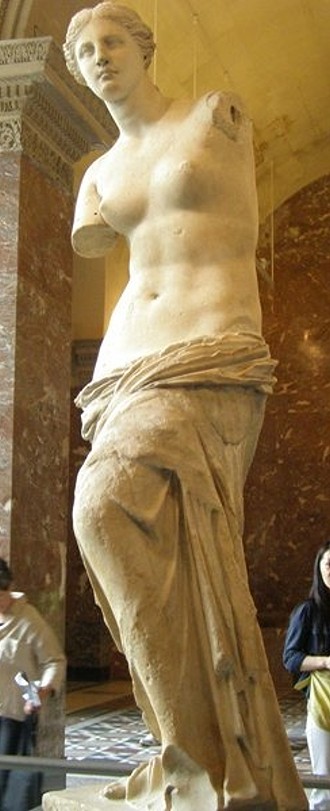
Milos History
Milos is famous for its lacy coastline with more than 75 small and big beaches of crystal, deep blue waters, multi-colored carved rocks and white-yellow coasts, it is certain that you will be impressed.
The volcanic activity in ancient years has endowed Milos island with an exciting variety of gorgeous landscapes, consequently offering the visitor a wide range of activities. The funny shapes of the rocks and their wonderful colors at the beautiful white sandy beaches are one expression of the volcanic features of Mílos; the economic activity is another: minerals such as obsidian are excavated here. What is more, one of the most ancient mines in the Mediterranean is on this island.
References had been made by Hippocrates to the peculiar morphology of spectacular caves (Papáfragkas and Sykiá) and a multitude of thermal springs (Kanáva, Alykí, Provatá, Pikropiyí).The diving enthusiasts will find a paradise in the underwater caves in the triangle formed by Mílos, Kimolos and Polýegos islands.
The island’s villages are lovely too: the stately Pláka (the island’s capital), the harbour of Adámantas, the beautiful Hivadolímni, the marvellous Emporiós with the little lagoon of Revary and the old iron mines.
As far as archaeology is concerned, Mílos is an ideal destination: the early Christian catacombs, a prehistoric settlement in Fylakopi and the mining museum (exhibiting 11,000 years of mining history) are definitely worth a visit.
Enjoy 80 amazing beaches with your better half; among them stands out Kléftiko with its turquoise waters and Sarakíniko with white sharp rocks cutting deep into a sheer cliff; add the unique lunar landscapes, the rocky secluded caves, the mysterious catacombs, the “sleeping” volcanoes and a picturesque Cycladic Chóra and experience a unique version of romance!
ou must visit as many beaches as you can! The white rocky landscape that embraces Sarakíniko forms an once-in-a-lifetime encountered lunar landscape while on Kléftiko, which can be reached only by boat, you can dive in secluded rocky caves with crystal clear waters. Add the wild beauty of Alogomántra, the open cave of Papáfragkas, the sheltered Ahivadolímni- the biggest beach on the island where also the island’s camping site is situated- and the beaches of Fyripláka, Yérakas and Tsigrádos adorned with grayish-red rocks.
Only on Milos and its neighbour, Kimolos , will you encounter small colorful houses by the sea, the so-called “sýrmata”, which the fishers used as shelter for their boats in winter. Other sites worth visiting are the Catacombs of Tripiti and the mystical Sulfur Mines. The whole area of Trypití is full of caves carved on the rock that were used as family tombs.
Another highlight is the white-washed Chóra adorned with beautiful churches, such as Panayiá Korfiátissa and the Catholic Church and well worth visiting Museums such as the Folk Art and the Archaeological Museum, where also a replica of the masterpiece of Aphrodite of Mílos is kept. A true copy of Aphrodite de Milo rises in the Museum Entrance (Room A), which was made in the workshop of the Louvre Museum.
Adámantas, built like an amphitheatre overlooking the Aegean, is the second biggest natural harbour in Greece and is quite famous for its frenetic nightlife.
Set off with your partner on a walking tour following ancient-old paths, which used to be the only “road network” until the previous century. Many of them lead to secluded beaches of pure wild beauty. Try easy routes like the one starting from Catacombs and ending at Profétis Elías (2,5 km, 35’); more difficult routes like the route Filakopí- Papáfragkas -Sarakíniko- Mandrákia (9km, 3hr) or a five-hour-route from Cape Vani to Áyia Marina boasting an astonishing landscape variety. The area of Ahivadolímni is ideal for wind-surfing, whereas the dirt road network in the areas of Emporió and Trahilas is perfect for off-road adventures.
Wander around the castle district at dusk when the sun washes Chóra with its warm golden light… The Castle’s top, the benches on the courtyard of Panayiá Korfiátissa church or Panayiá Thalassýtra are all ideal spots to enjoy this breathtaking scenery that will certainly weave a powerful spell on you… How about private dives on secluded beaches and well-hidden rocky caves? And if you are in a boat you will find yourself on beaches that you have never thought of putting foot on in your life!
Milos is an ideal island to visit with the Hellas Yachting Boats. You will discover her sun kissed beaches and the hidden secrets of her sea caves.
Tinos
One of the most enchanting yet less known islands of the Cyclades, Tinos is the religious centre of the country thanks to the church of Panayia Meyalóhari (the Blessed Virgin Mary). Pilgrims from all over the country come here to fulfil their vows and to seek spiritual comfort.
Kea
Due to its proximity to Attica, Kea is an easily accessible beauty with a scenery variety: steep mountains, small fields, olive groves, vineyards, valleys, picturesque coves and off-the-beaten-track beaches. On the island with the largest oak forest in the Cyclades, bird-watching is a real delight.
Kythnos
Also called “Thermiá” on account of its thermal springs, Kythnos is very close to Attica; still, it is one of the less visited islands of the Cyclades.
Anafi
Greek Mythology has it that Anafi, a paradise of pristine beauty and “exotic” beaches washed by crystal clear waters, had emerged from the bottom of the Aegean sea to give shelter to the Argonauts.
Ios
The locals call their island “Nios” but its formal name comes from “ion”, the Greek name for the flower violet. It is said to have been the birthplace of Homer’s mother and the place of his own tomb.
Folegandros
Remaining untouched by the growth of the tourist industry, Folegandros (or Polykandros) offers complete relaxation in a typical Cycladic landscape. The Greek mythology refers to Folégandros as son to Minos and head of the first colonists on the island.
Serifos
Ideal for a relaxed holiday, Serifos is a typical Cycladic island with white villages, quiet harbours, golden beaches, bare hills and beautiful landscapes. The mild tourism growth has not affected the island’s nature and traditional features.
Kimolos
This tiny and extremely beautiful island lies in the western part of the Cyclades, close to Milos island. Possessing a volcanic soil and a unique variety of minerals, it is famous for its fantastic beaches, ranging from thin sand to pebbles.
Sifnos
Sifnos will definitely turn a holiday into an unforgettable experience, having a rich tradition in pottery and gastronomy. Due to its gold mines, it used to be one of the richest islands in the ancient times.
Sikinos
Escape from everyday stress and anxiety on this small island, located between Íos and Folégandros. Sikinos is a typical Cycladic island, with terraces, low stone fences and numerous country chapels dotting a scenery bathed in the wonderful green and blue waters of the Aegean.
Iraklia
Iraklia is a tiny island with only 115 residents located at the western edge of the Small Eastern Cyclades island group. Dense vegetation, natural springs, smooth hills, crystalline waters (with shipwrecks at the sea-bottom!), scenic bays and caves are the characteristics of this unspoiled paradise in Cyclades
Schinoussa
Schinoussas is located at the centre of the Small Eastern Cyclades island group, south of Nàxos and north-east of Iraklia. It is a tiny island with three villages: Hora, Mesaria and Mersini.
Koufonisia
Koufonissia is a small group of two islands, Pano Koufonìsi (Upper Koufonìsi) and Kato Koufonìsi (Lower Koufonìsi), that are separated by a narrow strait. They are located southeast of Nàxos and west of Amorgos; Pano Koufonìsi is inhabited, with a land area of 5.5 sq. km and a population of 366 residents
Donoussa
Donoussa is the northernmost island of the Small Eastern Cyclades is located east of Nàxos and north of Amorgos. The island has a land area of 13.5 sq. km and numerous coves some of which hide magnificent sandy beaches.
Aniparos
The islet of Antiparos, lying southwest of Paros, is ideal for a relaxed and serene holiday and can easily be reached from Punda or Parikia by boat. The ancient name of Antìparos was Oliaros.
Amorgos
The island of “The Big Blue” – a large part of the Luc Besson film was shot there – is at the southeasternmost point of the Cyclades and it displays a very special scenery: mountains, cliffs ideal for climbing, terraces, precipices and picturesque coves with lovely waters.
Syros
This is the island where Greek tradition and western influence come to a harmonious marriage. Ermoúpoli (meaning “the city of Hermes”) is the island’s capital town and has been the first important trade and industrial centre of the country in the 19th century.
